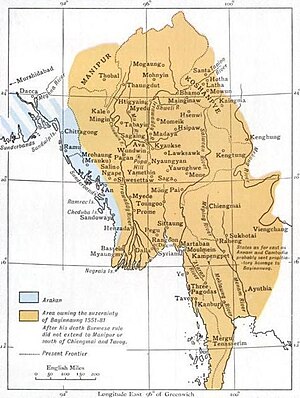Mongkawng
| Mongkawng State (Möngkawng) | |||||||
|---|---|---|---|---|---|---|---|
| State of the Shan States | |||||||
| 1215–1796 | |||||||
 Mogaung (Mongkawng) in a map of the Toungoo Kingdom | |||||||
| History | |||||||
| History | |||||||
• Möngkawng state established | 1215 | ||||||
• Annexed by the Kingdom of Burma | 1796 | ||||||
| |||||||
| Today part of | Myitkyina District, Myanmar | ||||||
Mogaung (Burmese: မိုးကောင်း) or Möngkawng (Tai Nuea: ᥛᥫᥒᥰ ᥐᥩᥒᥰ; Chinese: 孟拱) was a Shan state in what is present-day Myanmar. It was an outlying territory, located away from the main Shan State area in present-day Kachin State. The state existed until 1796. The main town was Mogaung (Mong Kawng).
History
According to legend a predecessor state named Udiri Pale had been established in 58 BC. The area was said to have been inhabited by the Tai Long. According to Tai chronicles the kingdom was founded in 1215 by a saopha named Sam Long Hpa who ruled over an area stretching from Hkamti Long to Shwebo, and extending into the country of the Nagas and Mishmis.[1]
Möngkawng (Mong Yang) was occupied by China between 1479 and 1483, after regaining independence it was again briefly occupied by China in 1495. From 1651 to 1742 the state was occupied by the Ava-based Kingdom of Burma and following a period of less than thirty years it was again occupied by Burma from 1771 to 1775. Finally Möngkawng was annexed by the Ava Kingdom in 1796.[2]
After becoming part of Burma Möngkawng was ruled by administrators named wuns. During British rule in Burma it became part of the Myitkyina District of the Mandalay Division.[3]
In Chinese chronicle Ming Shilu, the state was known as Mengyang and was under Yunnan as a pacification superintendency.[4] In the same chronicle, the kingdom is said to extend to the east to Jinsha River in China, south to Ava-Burma, west to the territory of Da-Gula and to the north till Ganyai, a polity near Daying river.[5] It is asserted that it was originally under the territory of Lu-chuan and it is to Mongkawng and Da-Gula where Si Jifa, the ruler of Mong Mao fled after the destruction of Lu-chuan by the Chinese during the Luchuan–Pingmian campaigns.[6]
Rulers
The rulers of the state bore the title Saopha.
Saophas
- 1663–1673: Sui Yaw
- 1673–1729: Sui Kyek
- 1729–1739: Hum
- 1739–1748: Haw Seing (1st time) (d. 1777)
- 1748–1765: Haw Kam
- 1765–1768: Haw Seing (2nd time) (s.a.)
- 1768–1771: Maung Kiaw
- 1771–1775: Maung Piu (d. 1775)
- 1775–1785: Vacant
- 1785–1796: Yaw Pan Kyung
References
- ^ Imperial Gazetteer of India, v. 18, p. 137. - Myitkyina District, History
- ^ Shan (Tai) States
- ^ Nisbet, John (1901). Burma Under British Rule—and Before. Vol. 1. Archbald Constable & Company.
- ^ "79. Meng-yang polity which the MSL records as a 'prefecture" and later as a 'pacification superintendency' under Yun-nan. It is the polity known in Shan as Mong Yang or Mong Kawng and in Burmese as Mo-hnyin or Mogaung."(Wade 1994:274)
- ^ Wade 1994, p. 274.
- ^ Wade 1994, pp. 274, 309.
Bibliography
- Wade, Geoffrey (1994), The Ming Shi-lu (Veritable Records of the Ming Dynasty) as a Source for Southeast Asian History -- 14th to 17th Centuries, Hong Kong
External links
Coordinates: 25°18′N 96°56′E / 25.300°N 96.933°E
- Articles with short description
- Short description with empty Wikidata description
- States and territories established in 1215
- States and territories disestablished in 1796
- Articles containing Burmese-language text
- Articles containing Tai Nüa-language text
- Articles containing Chinese-language text
- Coordinates not on Wikidata
- Shan States
- Kachin State
- All stub articles
- Myanmar history stubs
- Kachin State geography stubs